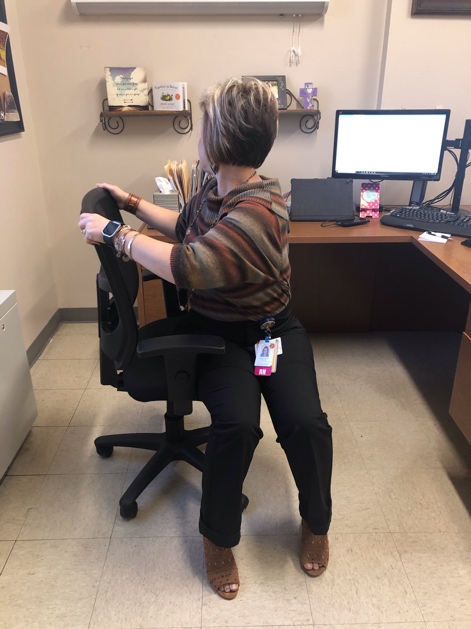Learn to De-Stress and Reset Right at Your Desk
![]() Print this Article | Send to Colleague
Print this Article | Send to Colleague
Health care professionals, regardless of the practice setting, are uniquely prone to stress and burnout. Reith (2018) states that burnout has reached “rampant levels” with over one half of physicians and one third of nurses experiencing symptoms. Burnout was first described by the clinical psychologist Herbert Freudenberger in 1974 when he observed emotional depletion and accompanying psychosomatic symptoms in the staff of a free clinic where he volunteered. He defined the phenomenon as exhaustion from excessive demands on energy, strength and resources in the workplace, resulting in symptoms that included malaise, fatigue, frustration, cynicism and inefficacy.
Stress and burnout can obviously have a detrimental effect on work performance. However, the negative effect on one’s physical and mental health cannot be overemphasized. Meditation, yoga and simple breathing can bring a sense of calm and peace that will improve work performance, reduce the body’s response to stressors and bring job back to the professional. A short yoga practice can be performed right at the desk. No special equipment or clothing is necessary for this practice, and it is available to everyone regardless of experience.
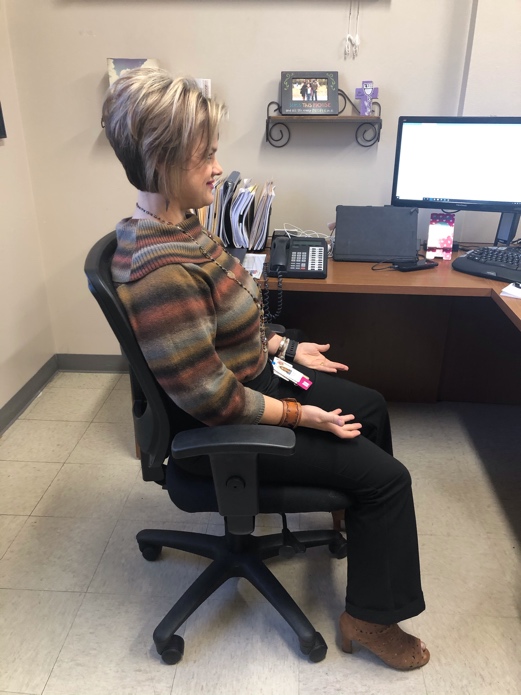 |
Start by establishing a quiet, calming environment. Close the door for privacy and dim the lights or turn off if there is a window to let natural light in. Attempt to reduce environmental noises or play a soft, meditative background music. None of these actions are required if they are not possible. However, the goal is to move the body into a parasympathetic state which is a relaxed state that promotes rest and healing. The environment can function as a strong, sustainable support to transitioning into this state during the chair yoga practice.
Begin the chair yoga practice with stillness. Sit in the center of the seat leaving space between spine and back of the chair. Sit tall, feet planted on the floor directly under knees with eyes closed, hands resting on thighs with palms up or down. Slowly move thoughts from the soles of the feet up the body ending with the face and scalp, ensuring that every part of the body is relaxed. Pay special attention to the jaw and face, letting the tongue fall away from the roof of the mouth. Take five deep breath cycles, in and out through the nose, filling the lungs completely on the inhale and completely exhaling all air possible. After the breath cycles, open eyes and begin the following chair yoga moves.
1. Seated Cat and Cow
Move feet and knees wide, turning feet out at a 45 degree angle and hands resting on the knees. Inhale, moving spine forward and up, gazing up with chin lifted, opening throat and heart to the ceiling. Squeeze shoulder blades together during lift, keeping shoulders down and knees aligned and tracking toward fifth toes. Exhale, tucking chin to chest, rounding spine, allowing knees to fall in slightly. Repeat cat/cow five times very slowly.
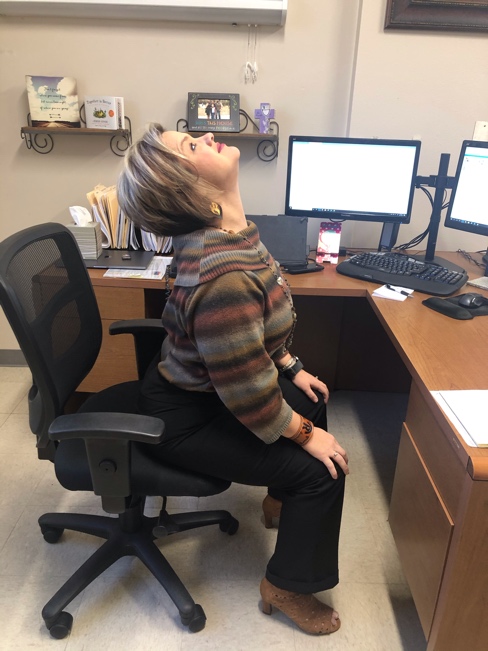 |
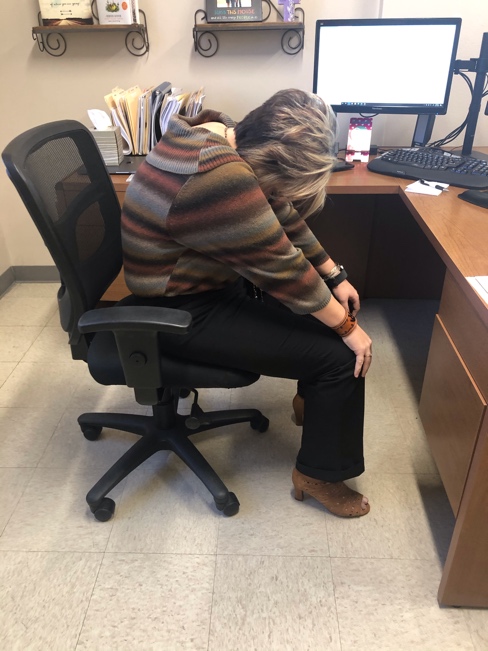 |
2. Left/Right Twist
Swing legs and feet to the right side of the chair. Plant feet directly under knees. Inhale, arms forward and up, then exhale, twisting to the right, using the back of the chair to deepen the twist. Stay in the twist. Inhale looking over left shoulder, exhale looking over right. Stay in the twist for five breath cycles. Swing legs and feet to the left side of the chair and repeat twist and breath cycles on this side.
 |
|
3. Left/Right Side Leans
Return to center of chair with wide knees and feet turned out at 45 degree angle, planted directly under knees. Inhale, leaning forward slightly, placing right forearm on the right thigh close to the knee. Extend the left arm up then bring the arm by the left ear opening the left side of the body. Taking five breath cycles, look down at right toes during inhale then twist head gently to looking up to the ceiling under left arm during exhale. Repeat on the other side.
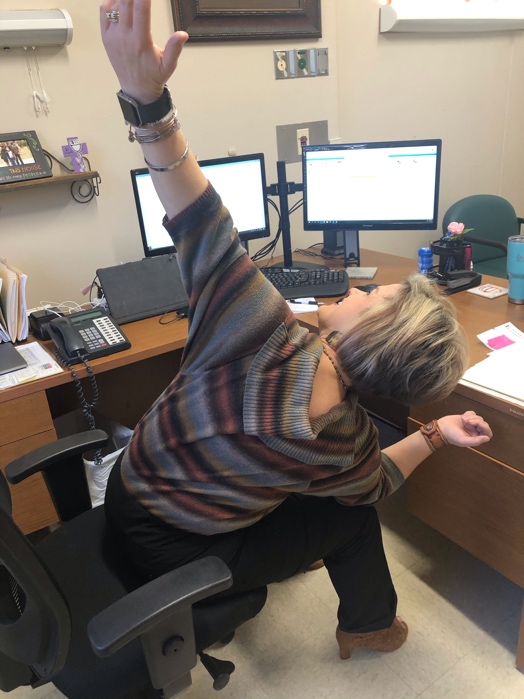 |
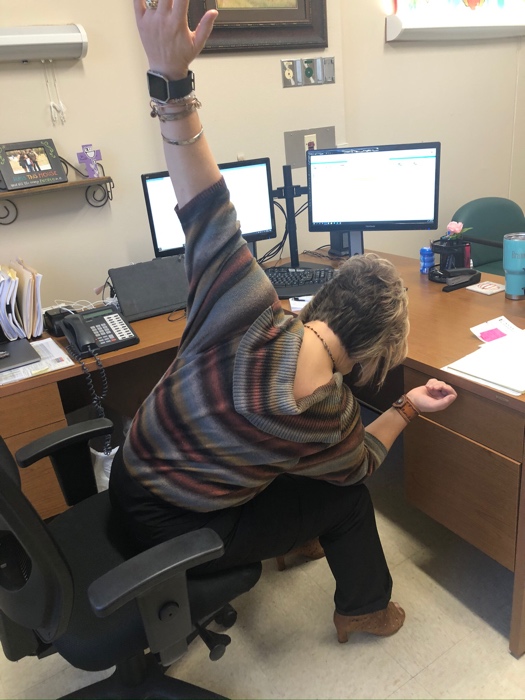 |
4. Final Pose, Forward Fold
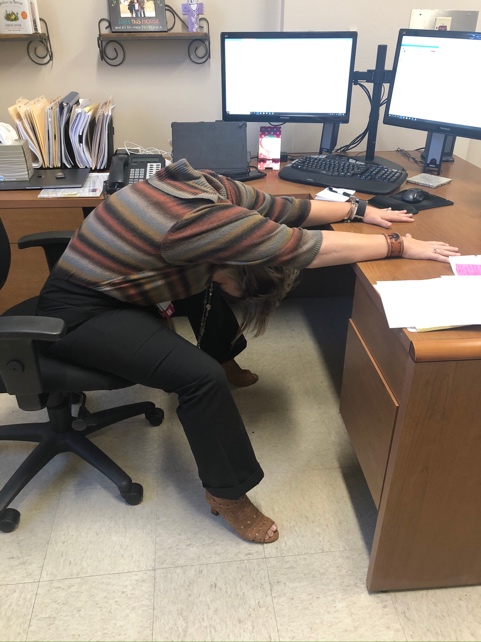 |
Push away from desk about 2 feet. Place hands on desk, arms straight, fingers wide and extended. Let head begin to drop between arms gazing down at the floor then close eyes. Knees are very wide to allow space for the upper body to drop toward the floor as far as possible, opening the shoulders. Take five breath cycles slowly.
End the practice the same as the beginning. Spend two to five minutes in a state of stillness. Try to keep the mind from wandering back to work. As thoughts enter the mind, acknowledge them but then release and return to a resting state. When ready to end, drop the chin down to the chest then gently let the eyes open, lifting head slowly.
This practice can be done at the beginning, end or during the lunch break. An abbreviated practice could be beneficial before and/or after a particularly stressful event.
We might not always be able to change our workplace environment and stressors, but we can learn to control our physical and mental response to the stressors. Incorporating a routine practice of meditation and yoga into daily routines can help restore a healthy work-life balance and mitigate the risk for stress and burnout to allow for a long, happy professional career.
Reference
Reith, Thomas (2018). Burnout in the United States Healthcare Professionals: A Narrative Review. Retrieved from URL https://www.ncbi.nlm.nih.gov/pmc/articles/PMC6367114/

